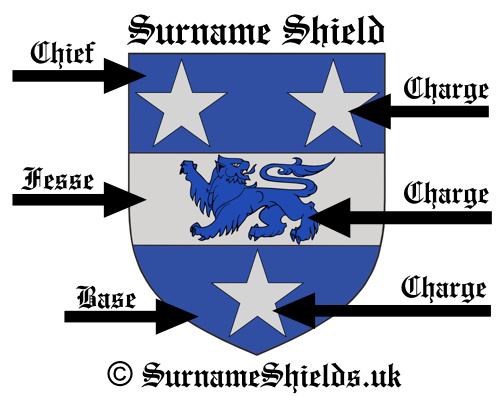
A family surname shield is also called an ‘escutcheon’ or ‘Arms’ and is the main component of a coat of arms, sometimes wrongly called a ‘family crest’.
Anciently, a shield was armour held on the arm or close to the body and was used to protect a soldier or warrior from arrows, spears and other weapons during battle. The word ‘shield’ derives from the Old English words ‘scild’ and ‘scildan’, both of Germanic origin. This word also appears as the Dutch and German word ‘schild’, meaning ‘divide’ or ‘separate’.
Shields contain separate areas as shown in the image here. These are:
- Chief: the top area of a shield.
- Base: the bottom area of a shield.
The various images appearing on a shield are known as a ‘charge’ and can include many heraldic images such as ermine marks, stars (mullets), crescents, many different birds (eagles, hawks, falcons, martlets, storks, etc.) and animals including lions, leopards, stags, bears, boars, wolves, griffins, dragons & wyverns, etc.
Shields also appear with different layouts and colours. Layouts can be plain shields of one heraldic colour (see below) or they can be divided into two or more heraldic colours such as ‘divided per pale’ (two separate halves vertically), ‘per fesse’ (two separate halves horizontally), a plain shield with a chief of a different colour, a shield with a chevron, chevronels, fesse, bend (a diagonal band), and more.
The shield colours (correctly known as ‘tinctures’) used in heraldry are two metallic colours and five tinctures:
- Gold (‘Or’ in heraldry)
- Silver (‘Argent’ or ‘Ar.’ in heraldty) – silver is also specified as ‘silvery white’
- Blue (‘Azure’ or ‘Az.’)
- Green (‘Vert’ in heraldry)
- Red (‘Gules’ or ‘Gu.’)
- Black (‘Sable’ or ‘Sa.’)
- Purple (‘Purpure’ or ‘Purp.’) – not used that often in heraldry.
Images appearing on surname shields may appear as one of the above colours or if the heraldic description (‘blazon’) specifies ‘proper’ it means its normal or natural colour. So a stork might appear as white, and a boar or bear would normally appear as black or brown.
The shield layout, images and colours are determined by the person who originally registered the coat of arms. Also, please note that coats of arms are registered or granted to an individual and not specifically a surname, but it is considered acceptable to display a shield, coat of arms or crest bearing the same surname as the recipient.
